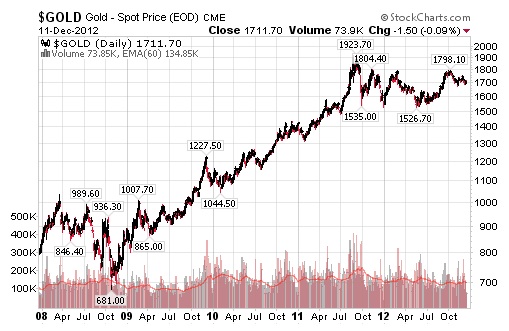
The Fed continues with its “QE forever” easing program. But something new has been added. The Fed now wants the unemployment rate to be at 6.5%, and they’ll keep rates around zero until that happens.
Bill Gross is founder and co-CEO of Giant PIMCO. Gross is a member of BARRON’S Roundtable and is highly respected on Wall Street. Gross is a bond-man, and I don’t ever remember him saying anything about gold.
Bill Gross says only gold and real assets will thrive in fiscal ‘ring of fire.’
By Claudia Assis – The latest round of quantitative easing made gold “even more attractive” and owning the metal should be considered as part of a diversified portfolio, analysts at bond giant Pacific Investment Management Co. said in a white paper posted Tuesday on the company’s website.
Pimco founder and co-chief investment officer Bill Gross, in his separate monthly investment outlook also posted Tuesday, said only gold and real assets would thrive in a “ring of fire” of U.S. fiscal problems.
Gold GG elicits black and white responses, the Pimco analysts said. Some investors “have a deep, almost religious conviction that gold is a useless, barbaric relic with no yield,” while others “love it” and see it as “the only asset that can offer protection from the coming financial catastrophe” always just around the corner, they said.
“Our views are more nuanced … Our bottom line: given current valuations and central bank policies, we see gold as a compelling inflation hedge and store of value that is potentially superior to fiat currencies,” the analysts said. “We believe investors should consider allocating gold and other precious metals to a diversified investment portfolio.”
Other investments, such as Treasury Inflation-Protected Securities, offer an inflation hedge. TIPS are also less volatile than gold. History shows, however, gold’s high correlation to inflation and gold’s unique supply-and-demand characteristics may lead to attractive valuations, the analysts said.
In his piece, Gross warned the U.S. would no longer be “the first destination of global capital” seeking safe returns if it doesn’t address its fiscal gap. The U.S. “will begin to resemble Greece before the turn of the next decade” if it continues to close its eyes to deficits, Gross said.
“Unless we begin to close this gap, then the inevitable result will be that our debt/GDP ratio will continue to rise, the Fed would print money to pay for the deficiency, inflation would follow and the dollar would inevitably decline. Bonds would be burned to a crisp and stocks would certainly be singed; only gold and real assets would thrive within the ‘ring of fire,’” Gross said.
A financial Armageddon is not around the corner, Gross said. “I don’t believe in the imminent demise of the U.S. economy and its financial markets. But I’m afraid for them,” he said. Gross runs the world’s biggest bond fund, Pimco Total Return Fund. The fund in August took in $1.3 billion in new cash, bumping total inflows for the year to $9.3 billion. -Claudia Assis
Below we see five years of gold. Big correction below 1800. If gold breaks out of this correction on the upside, we should see fireworks.

To subscribe to the 88 Yr Old Godfather of newsletter writers. Richard Russell’s Dow Theory Letters CLICK HERE.
About Richard Russell
Russell began publishing Dow Theory Letters in 1958, and he has been writing the Letters ever since (never once having skipped a Letter). Dow Theory Letters is the oldest service continuously written by one person in the business.
Russell gained wide recognition via a series of over 30 Dow Theory and technical articles that he wrote for Barron’s during the late-’50s through the ’90s. Through Barron’s and via word of mouth, he gained a wide following. Russell was the first (in 1960) to recommend gold stocks. He called the top of the 1949-’66 bull market. And almost to the day he called the bottom of the great 1972-’74 bear market, and the beginning of the great bull market which started in December 1974.
The Letters, published every three weeks, cover the US stock market, foreign markets, bonds, precious metals, commodities, economics –plus Russell’s widely-followed comments and observations and stock market philosophy.












